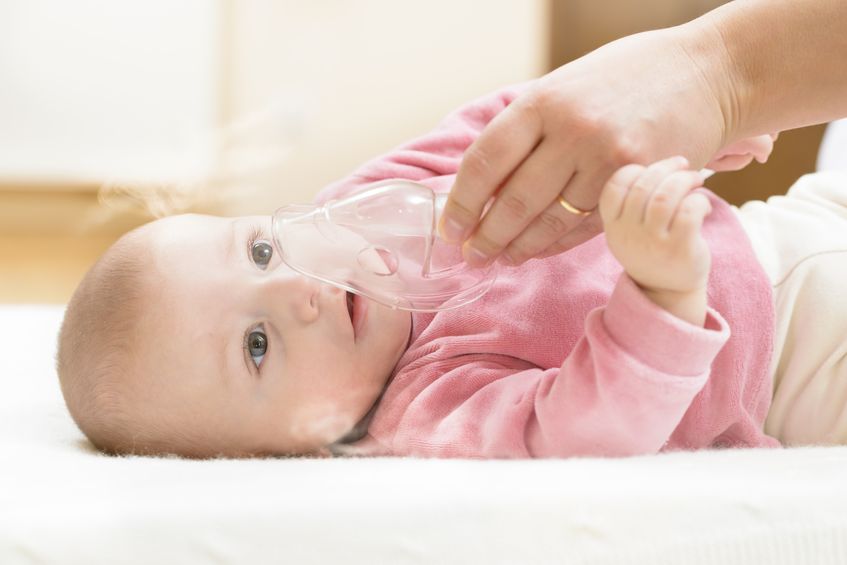
Bronchiolitis: symptoms, diagnosis, treatment
Bronchiolitis is a very frequent infection affecting the respiratory system
Bronchiolitis is an acute viral infection affecting the respiratory system of children under one year of age, with a higher prevalence in the first 6 months of life and a higher incidence between November and March
The infectious agent most involved (in about 75% of cases) is the respiratory syncytial virus (VRS), but other viruses may also be the cause (metapneumovirus, coronavirus, rhinovirus, adenovirus, influenza and parainfluenza viruses).
Infection is secondary to transmission, which occurs primarily through direct contact with infected secretions.
The infection phase typically lasts 6 to 10 days.
The infection affects the bronchi and bronchioles, triggering an inflammatory process, increased mucus production and obstruction of the airways with possible difficulty in breathing.
Factors that increase the risk of greater severity are prematurity, the age of the child (< 12 weeks), congenital heart disease, bronchopulmonary dysplasia, cystic fibrosis, congenital airway anomalies and immunodeficiencies.
CHILD CARE PROFESSIONALS IN NETWOK: VISIT THE MEDICHILD STAND AT EMERGENCY EXPO
What are the symptoms of bronchiolitis?
It usually begins with a fever and rhinitis (nasal inflammation); then there may be an insistent cough, which gradually worsens, and breathing difficulties – more or less marked – characterised by an increase in the respiratory rate and intercostal indentations.
It usually resolves spontaneously and without consequences.
However, in some cases, hospitalisation may be necessary, especially under six months of age.
In such young babies, there is often a drop in saturation levels (oxygen in the blood) and dehydration may be observed due to feeding difficulties and increased water loss caused by respiratory work.
In addition, in patients born prematurely or less than 6 weeks old, there is an increased risk of apnoea (prolonged pause in breathing) and their cardio-respiratory parameters should be monitored.
The disease is generally benign and resolves spontaneously in about 12 days.
How is bronchiolitis diagnosed?
The diagnosis of bronchiolitis is clinical, based on the course of symptoms and on the paediatric examination.
Only in particular cases, where considered necessary by the doctor, can certain laboratory and/or instrumental tests be carried out.
These include: the search for respiratory viruses on nasopharyngeal aspirates, determination of oxygenation by means of a saturation meter (arterial saturation <92% is an indicator of seriousness and the need for hospitalisation), arterial haemogasanalysis (an examination to assess blood oxygenation and, by measuring carbon dioxide, the effectiveness of gas exchange).
Very rarely, a chest X-ray is necessary (thickening and areas of airlessness may be found in several areas of the lungs due to impaired ventilation).
How can bronchiolitis be prevented?
A few simple rules of hygiene can reduce the risk of contracting bronchiolitis or avoid related infections that may worsen the clinical picture.
Always try to
- Avoid contact of younger children with other children or adults with airway infections;
- Always wash your hands before and after caring for your child;
- Encourage breastfeeding and provide adequate amounts of fluids;
- Give frequent nasal washes with physiological or hypertonic solution;
- Never smoke in the home, even in rooms other than those where the baby is.
How is bronchiolitis treated?
An infant with no breathing difficulties, with SaO2 > 94 % in air and able to feed himself can be treated at home under the careful care of the treating paediatrician.
Patients with bronchiolitis are usually treated with frequent nasal washes with aspiration of secretions and aerosol therapy with 3% hypertonic solution.
The latter helps the child to mobilise the abundant catarrhal mucous secretions.
Bronchodilators (drugs that dilate the muscles of the bronchi and thus improve breathing) can be used by inhalation 3-4 times a day if a clinical improvement has been observed after an initial “trial” administration in the paediatric surgery or at home.
Therapy should be discontinued if there is no evidence of efficacy.
Oral cortisone is sometimes prescribed, but the most recent scientific literature does not show that children receiving this treatment improve.
Routine use of antibiotics is not recommended, except in immunocompromised children or if a concomitant bacterial infection is suspected.
It is useful to divide meals by increasing the frequency and decreasing the quantity.
When hospitalisation is necessary, the child is given supportive therapy to ensure
- Adequate oxygenation of the blood by administering humidified and warmed oxygen (high-flow oxygen is only administered in severe cases);
- Adequate hydration, if feeding is difficult, through the administration of intravenous glucosaline solutions.
Bronchiolitis: when should the child be hospitalised?
In all cases of poor oxygenation or refusal to feed the child, according to the indications of the treating paediatrician, the paediatrician of the Emergency Department should assess the child for possible hospitalisation.
The following are considered as additional risk factors: prematurity or age under two months, concomitant chronic pathologies (bronchodosplasia, congenital heart disease, immunodeficiencies, neurological pathologies), reduced reactivity, difficulty in being cared for at home by the parents.
Read Also:
Chest Pain In Children: How To Assess It, What Causes It
Bronchoscopy: Ambu Set New Standards For Single-Use Endoscope


